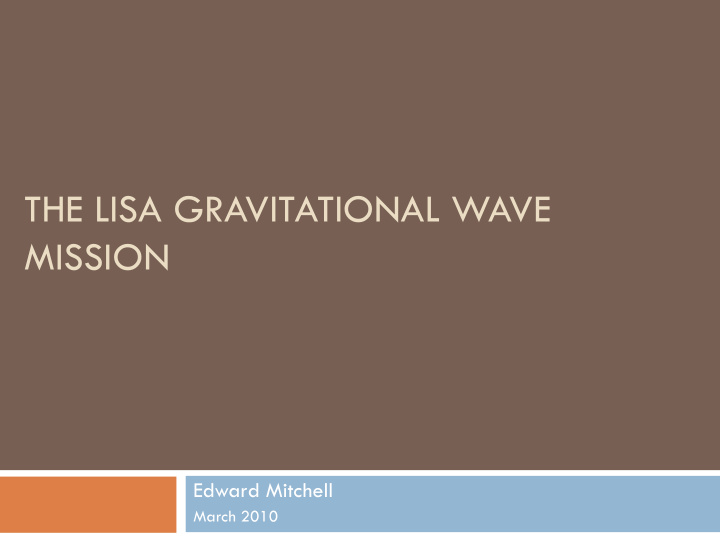



THE LISA GRAVITATIONAL WAVE MISSION Edward Mitchell March 2010
Gravitational Waves 2 Radiated by asymmetric changes in mass distributions (quadrupole moment or higher) Transverse, area preserving periodic strain in spacetime h≈10 -20 near earth Edward Mitchell March 2010
Gravitational Waves 3 Appear as time-dependent tidal forces in free-falling detector Fractional change in proper distance: L h L 2 Strain amplitude of binary source approximated as: Observation of increasing binary orbital frequency (eg. Hulse Taylor binary) Edward Mitchell March 2010
LISA 4 High power, predictable sources radiate below 10mHz Terrestrial gravity gradient/seismic noise limits earth based detectors to f>1Hz LISA target frequency range: 10 -4 -10 -1 Hz Galactic binaries and extragalactic supermassive black hole binaries Laser interferometry – frequency analysis of phase differences reveals periodic path length changes Edward Mitchell March 2010
5 Edward Mitchell March 2010
6
Gravitational Reference Sensor 7 Test mass follows geodesic path in spacetime TM position detected by capacitance measurements Micro-Newton thrusters maintain central TM Edward Mitchell March 2010
8
Instrument Noise 9 Optical path noise Eg. Laser shot and phase noise Mimics change in arm length Acceleration noise Real arm length changes due to spurious forces Dominates at low frequency (f<2mHz), scaling as 1/f A major component is due to Coulomb and Lorentz forces caused by test mass charging Edward Mitchell March 2010
The Particle Environment 10 Galactic Cosmic Rays (GCRs) and Solar Energetic Particles (SEPs) penetrate the test mass Particles are stopped/ejected, leaving a net charge GCRs have nearly isotropic, steady flux SEP events (flares, CMEs) increase charging by factor of 10 3 [Grimani et al. Class. Quantum Grav. 21 (2004) S629-S633] Edward Mitchell March 2010
Test Mass Charging 11 E<100MeV/n Primaries do not reach test mass (TM) 100-400MeV/n Primaries stop in TM 400-2000MeV/n Primaries pass through, secondary protons stop in TM E>2000MeV/n Primary & secondary protons pass though, secondary electrons stop Test mass charging modelled with GEANT Edward Mitchell March 2010
LISA Pathfinder 12 Technology demonstrator for launch in 2012 Single spacecraft at the L1 Lagrange point Observe charging and monitor particle fluxes LISA Technology Package [ESA] Edward Mitchell March 2010
Charge Management 13 UV photoelectron emission to maintain <10 5 e Q Two discharge modes: rapid/continuous Charge fluctuations in time domain have coherent Fourier components in frequency domain Minimise through continuous discharge, matching Q charge/discharge rate (within 0.1% for LISA) Charge rate varies due to stochastic arrival of particles: Edward Mitchell March 2010
LISA Pathfinder: Charge Management 14 Measure and Q Q over 1 hour periods Charging shot noise and rate fluctuations not resolvable Expected to exceed LISA noise budget Noise resulting from a net charging rate, for 1 day integration period, matching rates to ±10es -1 and maintaining Q<10 5 e Dashed line = largest coherent Fourier component Red line = LISA noise target Blue line = LISA Pathfinder noise target Edward Mitchell March 2010
LISA Pathfinder: Radiation Monitor 15 Use radiation monitor to validate models and track short term flux changes Try to characterise transfer function between monitor data and test mass charge rate Develop radiation monitors and charge management for LISA Edward Mitchell March 2010
References 16 Edward Mitchell March 2010
Recommend
More recommend